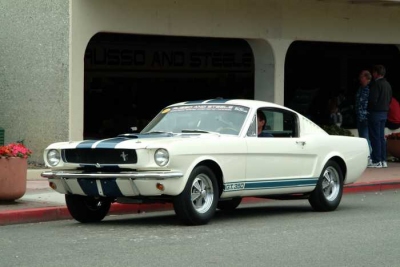SCM Analysis
Detailing
This 1965 Shelby GT 350 sold for $324,500 at Russo and Steele’s Monterey sale, held on Aug. 20, 2005.
The new-for-1964 Mustang was a hit, but in standard form it had no teeth. Ford wanted a performance version of the car that could go after the Corvette in SCCA B Production racing, so it tagged Carroll Shelby to build one. Starting with the new fastback body style and a 289-ci, 271-hp “K code” V8, Shelby created the GT 350. It was the right car at the right time, putting Ford on the SCCA racing map, and leading Shelby to a promising future modifying Mustangs.
Today the GT 350 is regarded as the purest of all the Shelby Mustangs built from 1965-1970. With the Shelby-ized “K code” making 306 hp and bellowing through a barely legal factory side exhaust, the car is pure performance nirvana. Its close-ratio aluminum Borg Warner T-10M four-speed with steep, 3.89:1-geared Detroit Locker differential, quick steering, competent suspension, and big brakes make it one of the few cars to leave Detroit that was truly ready for track duty right out of the box.
In the Shelby world, 1965 GT 350s have always been the ones to own, as they are wonderful, multi-purpose street and track cars, along the lines of a Ferrari 250 SWB. Shelby went on to produce many more Mustang variants, including big block GT 500s, but to the cognoscenti, the first were the best.
Shelby produced just 521 street cars and a scant 34 R-model competition GT 350s in 1965. The earlier the car is, the better, where values are concerned. “Two-digit” cars, as they have become known, are the most valuable. These were Shelby’s first allotment from Ford, and as such, they occupy a unique place in Shelby Mustang history.
Early cars have the battery in the trunk, 16-inch Moto Lita steering wheels (just like the Cobra), and other unique features. As production increased, many running changes occurred. Soon the GT 350 went to a 15-inch steering wheel, the quality of the fiberglass hoods improved, and the battery moved back up front around car #325. So if you’re shopping for a ’65 Shelby, you want to buy a car with the battery in the trunk, a shoddy hood, and as low a serial number as you can find.
But make sure you do your homework, as there is a reason why almost any car that seems like a great deal is being sold so cheaply. Many GT 350s have “storied” pasts (not the good kind of stories), and have shed many of their important and valuable original parts over the years. The Shelby American World Registry, an invaluable resource, has nearly every car listed, along with all known history. I also recommend an inspection by a Shelby expert.
As the owner of a ’65 GT 350, I follow this market quite closely, and values have taken a significant jump since 2002. I have seen good driver-quality, three-digit serial number cars selling in the $150k-$200k range, and concours examples bringing offers of $250k-$275k that were turned down. Two-digit cars are practically non-existent on the open market, and I know of just two that have sold privately in the last two years.
Our subject car, #18, is a fantastic example of an early Shelby GT 350. I inspected the car at the auction, and was impressed with its quality. The long-term owner was present, and was quite obviously as fastidious as described in the auction catalog. He had great paperwork, the car had a fully documented history, and it was restored properly. While not the best example extant, it is the kind of car I like to see.
As such, I recommended the purchase of #18 to a client of mine. We discussed the values outlined above, and he decided that it was best to pay a premium here to get a premium car. It appears as if a few other bidders came to the same conclusion, as there was active bidding all the way up to the hammer. My client ended up with the winning bid, and is thrilled with his new Shelby GT 350.
I have always said that a live auction is the best way to establish value. It is a marketplace where the seller’s perception of worth is met with the harsh reality of what buyers will actually pay. This auction shows that there is a strong demand for great ’65 GT 350s, and not enough cars to go around. While the price paid here was substantial, in today’s market, I don’t think it was a ridiculous amount of money for entry into the elite “two digit” club.
A fair deal for all involved. Consider the bar for ’65 GT 350s raised yet again.
(Comer is founder and president of Colin’s Classic Automobiles, as well as being an avid Shelby collector and historian. Historical and descriptive information in this profile courtesy of the auction company.)
